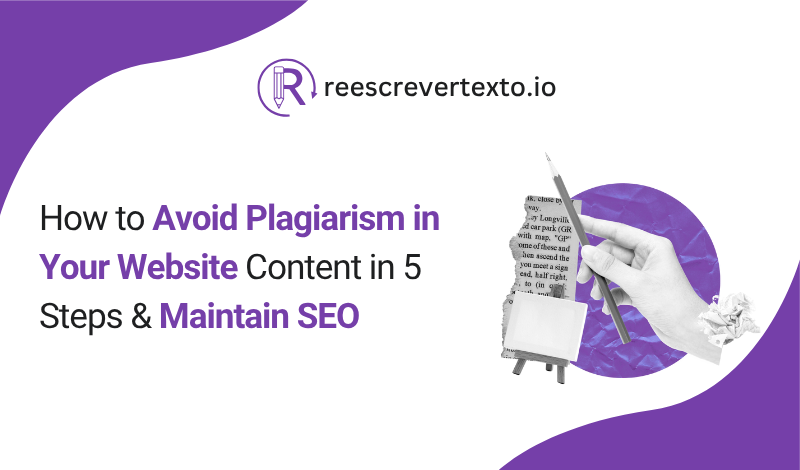
How to Avoid Plagiarism in Your Website Content in 5 Steps
Creating content for your website can be exciting until you face the fear of plagiarism. You work hard, but sometimes ideas overlap, phrases sound similar, or quotes get used without proper credit. That not only hurts your brand but also puts your search visibility at risk.
Search engines value originality, and even accidental duplication can lower your site’s credibility. You need strategies that help you stay authentic while ranking high. That’s why understanding how to avoid plagiarism and protect your SEO is essential.
What Is Plagiarism in Website Content
Plagiarism means using someone else’s words or ideas without giving proper credit. It can appear as copied sentences, reworded paragraphs, or uncredited quotes. Even unintentional overlap from research can count as plagiarism.
When that happens, search engines flag your page as duplicate content. That lowers your authority and affects ranking. For brands that rely on organic traffic, one copied paragraph can do real damage. A good plagiarism detector helps you identify such risks before publishing. However, you can even use Rewrite text tools to avoid plagiarism.
Why You Need to Avoid Plagiarism
Original content builds trust and shows your expertise. Visitors want to read something that reflects your unique perspective, not something they’ve already seen. When your writing is authentic, readers stay longer and engage more.
There’s also an SEO angle. Google rewards websites that produce fresh, valuable, and original information. If your content looks copied, your site might lose ranking. Avoiding plagiarism protects your reputation and your visibility.
When you wonder how do I check for plagiarism, you’ll find several online tools that make detection simple. Some even show sentence-level matches, giving you complete control over corrections.
How to Avoid Plagiarism in 5 Steps?
Research Smartly but Write in Your Own Words
Reading from multiple sources helps you learn, but rewriting directly from one is risky. Understand the topic first, then explain it in your own way. Combine ideas from different places to form a unique version. That habit keeps your writing natural and original.
It’s okay to take inspiration, but you should add your insight. Fresh examples or real experiences make your content stand out even when the topic is common.
Use Plagiarism Checkers Before Publishing
Online tools can scan your content for duplicates. They compare your writing against published pages to show matching text. That gives you a chance to rewrite or adjust before posting.
If you’re wondering how to check for plagiarism free online, several tools allow instant scanning without signup. You can even use a free AI plagiarism checker for students if you want fast results for essays or academic writing.
Quote and Credit Properly
If you must use someone’s words, place them in quotation marks and cite the source. That shows honesty and professionalism. Quoting adds authority when used the right way.
You can also link back to the original page. That signals to search engines that you’re referencing, not copying. Both readers and bots recognize transparent sourcing as ethical writing.
Use AI Rewriters Wisely
AI tools help refine tone and grammar, but over-reliance can cause repetition. You can use them for clarity, not for lifting sentences. Review every generated line and personalize it to fit your brand’s voice.
A good approach is to merge AI assistance with your own creativity. That balance keeps your article fresh and SEO-friendly. When you’re unsure about originality, you can run your content through a plagiaism detector for verification.
Maintain a Consistent Content Strategy
When you plan your content calendar, assign topics carefully. Avoid rewriting the same subject again and again. If you must revisit an idea, update it with new data, trends, or perspectives.
Search engines love consistency that shows growth. Fresh updates not only prevent duplication but also signal relevance over time.
Uses of Non-Plagiarized Content
Clean content strengthens brand reputation and builds long-term SEO success. It attracts backlinks, drives engagement, and keeps your site safe from penalties.
Blogging: Share insights with a unique voice.
E-commerce: Write distinct product descriptions.
Education: Publish guides or lessons that explain topics clearly.
News Portals: Report facts but interpret them from your angle.
Digital Marketing: Create original campaigns and case studies.
Conclusion
Avoiding plagiarism is not just about ethics; it’s about long-term growth. When you write fresh content, your readers trust you more and your rankings improve. Unique writing reflects both creativity and professionalism.
AI tools, proper citations, and smart planning can help you stay on track. Every article becomes a chance to build your brand voice. If you want steady traffic and authority, originality must come first.
Related Blog: What is Plagiarism? Definition, Types, Example
FAQs
What is the simplest way to avoid plagiarism?
Understand the topic before writing and express it in your own words. Always run your content through a reliable checker before publishing.
Does Google penalize copied content?
Yes, Google may lower your ranking if it finds duplicate content. It treats originality as a key ranking factor.
Can I use quotes in my articles?
Yes, quoting is fine if you credit the source properly. Always use quotation marks and a citation link.
Are AI tools safe for writing unique content?
AI tools are useful for structure and grammar, but you should edit the output manually to maintain originality.
What happens if I accidentally copy content?
Even unintentional copying can affect SEO. Check and edit your text before uploading it to avoid problems.
How often should I check my site for duplicate content?
Run periodic checks, especially when updating old pages. That helps catch unintentional repetition.
Can two sites have similar topics without plagiarism?
Yes, as long as the presentation, examples, and writing style differ. The idea can be shared, but the expression must be your own.